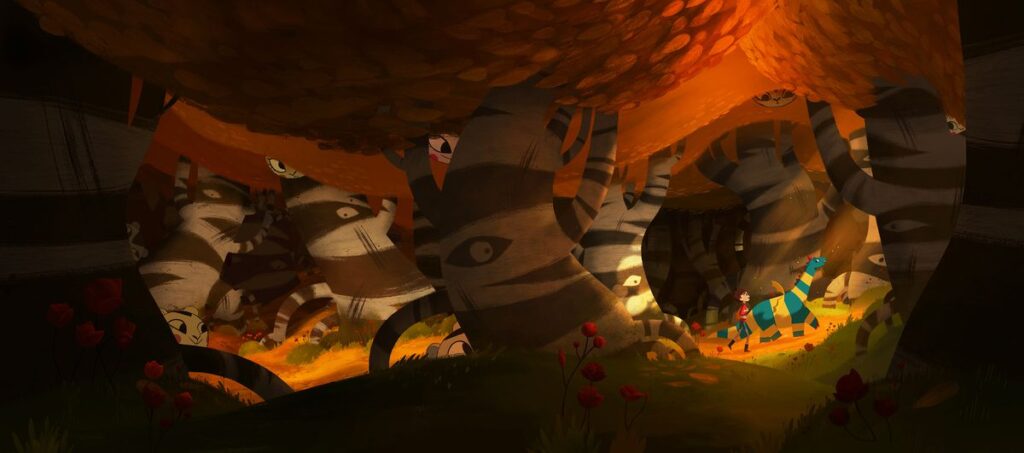Ruth Stiles Gannett’s classic children’s book My Father’s Dragon seems to come straight from the subconscious. For some kids, it might feel comforting and full of wonder. But for those of us who discover it as adults — as I did recently, reading it to my 5-year-old — it just feels overwhelmingly strange. (Actually, my kid thought it was weird, too.) The 1948 book tells the story of a young boy who gets into a disagreement with his mother and runs away to Wild Island, where he must outwit some tragicomic talking animals to rescue the candy-striped young dragon they have enslaved.
Netflix’s new animated film adaptation, made by the great Irish studio Cartoon Saloon (The Secret of Kells, Song of the Sea, Wolfwalkers), keeps that top-level plot summary, some of the characters, and the indelible design of Boris the dragon, as illustrated by the author’s stepmother, Ruth Chrisman Gannett. Boris is plump and puppyish, striped in blue and yellow, with floppy ears and little golden wings. Apart from that, the film discards almost everything else. Director Nora Twomey (The Breadwinner, Secret of Kells) and screenwriter Meg LeFauve (Pixar’s Inside Out) have rebuilt the Gannetts’ fragmented, surreal little parable into something that’s more like a conventionally structured kids’ movie, but they’ve also made it more exciting and resonant. It’s a lovely film.
In this version, the boy, Elmer (Jacob Tremblay) — who will, we understand, grow up to be the father of the unseen, elderly narrator (Mary Kay Place) — leads a happy life in a tiny town with his single mother (Golshifteh Farahani), who runs a thriving neighborhood store where everyone’s needs are taken care of. Then hard times come. (Twomey makes the transition clear by having a bright tangerine fall from an overflowing crate to the floor, where it rolls and evaporates — a wonderfully understated, eloquent gesture.) Boy and mother move to a dilapidated boarding house in a bustling industrial city, where he struggles to adapt to their rootless, impoverished new circumstances. After Elmer’s mother chases off an alley cat he takes in, he runs after it, down into the city’s guts. Passing through a narrow crack, he emerges in a fanciful new reality where the cat talks (with Whoopi Goldberg’s mischievous purr) and ushers him to adventure on the back of an excitable baby whale.
Image: Netflix
This new frame grounds the story in a psychological reality the book never had, while also honoring its midcentury American genesis. Twomey and LeFauve’s expansive ideas don’t stop there. In the book, the animals of Wild Island are vain and lazy, and when the dragon falls from the sky, they capture him and put him to work as an air taxi, flying them across a river they can’t be bothered to swim across or walk around. The film’s Wild Island is a more complicated, metaphorical, and morally ambivalent place.
This island, dome-shaped and forbidding, is constantly sinking into the sea. Its animals, desperate to survive, have captured Boris (Gaten Matarazzo) because he’s powerful enough, when harnessed to the rock of the island itself, to pull the whole landmass up out of the water. The more he pulls, the more it sinks, but Saiwa the gorilla (Ian McShane), the animals’ authoritative, caring, but blinkered leader, is fresh out of other ideas. There are mysteries, too: a gaping cavern of bright white fire at the island’s summit, the legend of an all-knowing turtle somewhere in its heart, and crude hieroglyphs of a fire-breathing “after-dragon” that Boris longs to be. The dragon and the island seem to have something to do with each other, but what?
Unlike the book, which saves the meeting between boy and dragon until the end, Twomey and LeFauve waste no time bringing them together. Elmer and Boris explore the island together, meeting a rhinoceros trapped with her baby, a campy crocodile and his brood, some savage yet adorably roly-poly tigers, and a troupe of angry, spherical hamsters. The animals are played for laughs and pathos by a stellar cast that includes such treasures as Dianne Wiest, Judy Greer, Chris O’Dowd, and Alan Cumming. McShane, his gorgeously rich voice marinated in fury and worry, is scene-stealing as the gorilla with the weight of the whole island on his shoulders.

Image: Netflix
Tremblay and Matarazzo strike up a rapport as the resourceful, serious boy and the foolish, hopeful dragon. As is so often the case in stories like this, the child and his fantastical companion are two sides of the same coin: mature and immature, closed-minded and open-hearted, ego and id. Naturally, they will help each other overcome fears, accept new realities, and move on. That’s the part of the film that feels most formulaic. But it’s still touching, especially in the context of Elmer’s “real” life in the city, and what he’s running away from there. Still, what lingers longest after the credits roll is the social allegory of the island’s animals, drowning not through ignorance or laziness, but because they can’t understand how to save themselves and are willing to push that burden onto someone else.
Cartoon Saloon fans will assume this goes without saying, but for the uninitiated: My Father’s Dragon is beautiful. It’s 2D animation, illustrated in an economical but expressive style. It has a cleaner, less obviously hand-drawn look than untamed Wolfwalkers, but Twomey’s keen sense of scale and her simple, striking compositions create a powerful emotional geography for the story, and a surprisingly epic, catastrophic canvas for the action. This is a director and a studio at the forefront of their craft, with the confidence to take a beloved classic and turn it into something bigger — and deeper.
My Father’s Dragon is streaming on Netflix now.

